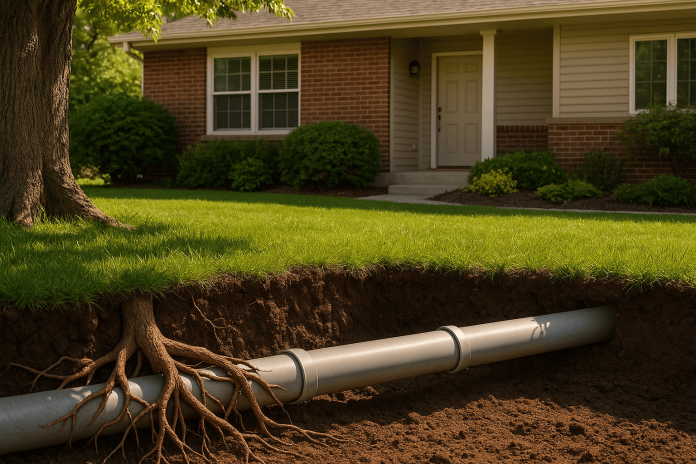For many homeowners, plumbing issues seem to appear out of nowhere. One of the most common yet hidden culprits is tree roots. Because roots naturally grow toward water and nutrients, your underground pipes can quickly become their perfect target. Left unchecked, root invasion can cause blockages, leaks, and even burst pipes. The good news is that there are ways to prevent the problem and effective solutions if it has already occurred. Let’s look at why tree roots are attracted to pipes, the warning signs you should know, and the repair options available.
Why Tree Roots Target Your Pipes
Tree roots grow wherever there’s a steady water source. If you have older clay or concrete pipes, small cracks or loose joints may allow water to seep into the soil. Roots are drawn to this moisture and can slip inside even the tiniest gap. Over time, they expand, causing pipes to weaken, fracture, and eventually collapse.
Sydney homeowners, in particular, often deal with trees like gum, jacaranda, and fig, all of which have aggressive root systems. These roots can travel several metres underground in search of water. Once inside your pipes, they don’t just cause clogs, they keep growing until they take over the entire line.
Signs That Tree Roots May Be Damaging Your Pipes
Spotting the early signs of root intrusion is key to avoiding a costly repair bill. Some of the most common warning signs include:
- Slow drains: Toilets, sinks, or showers that are taking longer than usual to clear.
- Recurring blockages: If you’re constantly reaching for the plunger or calling a plumber, roots may be the reason.
- Bad smells: Sewer odours from drains or in the garden often point to damaged pipes.
- Gurgling noises: Strange bubbling or gurgling sounds when water drains can signal trapped air caused by roots.
- Soggy patches in the yard: Unexplained wet ground or extra-green grass along the sewer line may mean water is leaking underground.
If you notice more than one of these symptoms, it’s worth arranging a professional inspection before the damage gets worse.
Prevention Options for Homeowners
Strategic Landscaping
One of the most innovative ways to avoid root intrusion is careful planting. Place trees and large shrubs well away from your main sewer or stormwater lines. If you’re considering new landscaping, choose species with less aggressive roots.
Regular Plumbing Inspections
For older properties, especially those with clay pipes, yearly or bi-annual CCTV drain inspections can make all the difference. Plumbers can detect minor root intrusions early, well before they turn into a serious blockage.
Physical and Chemical Barriers
Root barriers are another preventive measure, installed underground between trees and pipe systems. In some cases, plumbers may also use safe chemical treatments that discourage root growth near pipes. These should always be applied by a professional to ensure they don’t harm the environment.
Upgrading Old Pipes
If you own an older home, upgrading to PVC or HDPE pipes is an investment worth considering. These modern materials are far more resistant to root intrusion. In some cases, relining existing pipes can also act as a preventive measure, sealing cracks and weak points before roots get in.
Repair Options If Roots Have Already Invaded
Mechanical Root Cutting
This method uses augers or cutting blades to slice through roots inside the pipe. While it offers immediate relief from blockages, the roots often grow back, making it a temporary solution.
Hydro Jetting
Hydro jetting uses high-pressure water streams to blast roots and debris from pipes. It’s less invasive than cutting tools and cleans the pipe walls more thoroughly. However, like mechanical cutting, it may need to be repeated if roots regrow.
Pipe Relining (Trenchless Repair)
Pipe relining is a modern solution that creates a new “pipe within a pipe.” An epoxy resin liner is inserted into the damaged section, sealing cracks and preventing roots from entering again. This method doesn’t require digging up your yard and is a long-term fix that many Sydney homeowners now prefer.
Pipe Replacement
For pipes that are too damaged to reline, replacement is the only option. This involves either traditional excavation or trenchless replacement methods. Although it’s the most expensive solution, it guarantees a permanent fix for severely compromised pipes.
Costs and Long-Term Considerations
The cost of dealing with root intrusion varies depending on the method used:
- Mechanical cutting or hydro jetting: Usually the most affordable, but only a short-term fix.
- Pipe relining: A mid-range solution that provides long-lasting protection.
- Pipe replacement: The most expensive but also the most permanent.
Ignoring the problem, however, can lead to far more expensive issues such as Burst Pipe Repair, water damage to your property, and even structural risks. Preventive maintenance almost always costs less in the long run.
When to Call a Professional Plumber
DIY fixes may work for minor clogs, but tree roots require specialist solutions. You should call a plumber if:
- Blockages keep returning despite your efforts.
- Your water bills have suddenly increased, suggesting a hidden leak.
- You notice odours, soggy patches, or strange noises in your plumbing.
Look for a licensed plumber who offers CCTV inspections and trenchless solutions like relining. Professionals experienced in Commercial plumbing will also have the right tools to provide long-term fixes.
Conclusion
Tree roots may be a natural part of your garden, but when they invade your pipes, they can cause costly damage. By recognising the signs early, scheduling regular inspections, and taking preventative steps such as pipe upgrades or barriers, you can avoid serious problems. If roots have already entered your pipes, modern repair options like hydro jetting and pipe relining provide effective, lasting solutions. In the end, proactive care saves you money, protects your property, and keeps your plumbing system in top condition, whether it’s a minor Leaking Tap Repair or a primary underground pipe job.

